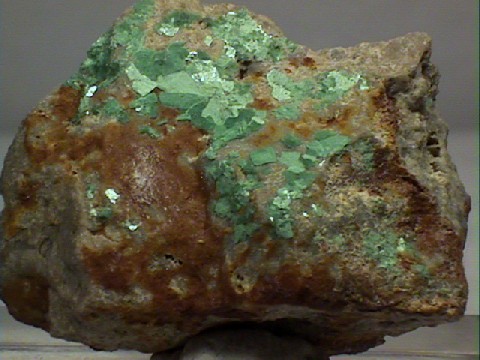 The Mineral ZUENERITE
The Mineral ZUENERITE
- Chemistry: Cu(UO2)2(AsO4)2 - 10-16H2O , Hydrated Copper Uranyl Arsenate
- Class: Phosphates
- Subclass: Arsenates
- Group: Autunite/Torbernite
- Uses: A minor ore of uranium and as mineral specimens
Specimens
The structure of zeunerite is composed of arsenate tetrahedrons linked to uranium-oxygen groups (called uranyl ions groups) that form distorted octahedrons. The arsenates and uranium groups form sheets that are weakly held together by water molecules. This structure produces the tabular habit, the one perfect direction of cleavage and the relative softness. It is an analogous structure to that of the phyllosilicates. Zeunerite's structure produces a rather exclusive symmetry, bar 4. Only a few minerals share this symmetry.
Zeunerite can lose water and convert to a different mineral called meta-zeunerite which belongs to the meta-autunite/meta-torbernite group of minerals. The change to meta-zeunerite will often produce a pseudomorph. A pseudomorph is generally an atom by atom replacement of one mineral's chemistry to form another mineral. The process leaves the crystal shape of the lost mineral intact. The word pseudomorph means false shape. In this case, the conversion is not so dramatic since it involves only the loss of a few water molecules and therefore a good pseudomorph is likely. The conversion is irreversible and ongoing and all collection specimens of a certain age are partially to totally converted. Fine zeunerite specimens should be stored in a closed container to avoid water loss. Remember, this is a radioactive mineral and should be stored away from other minerals that are affected by radioactivity and human exposure should be limited!
PHYSICAL CHARACTERISTICS:
- Color varies from the typical emerald green to yellow.
- Luster is vitreous, pearly on cleavage surfaces.
- Transparency: Crystals can be transparent to translucent.
- Crystal System is tetragonal; bar 4
- Crystal Habits include tabular square crystals dominated by two pinacoid faces. Bipyramidal crystals are also seen. Crystals can look cubic (pseudocubic) too. Also as crusts, micaceous, foliated and earthy.
- Cleavage is perfect in one direction (basal).
- Fracture is uneven.
- Hardness is 2 - 2.5
- Specific Gravity is approximately 3.2 - 3.4 (slightly above average for translucent minerals)
- Streak is a pale green.
- Other Characteristics: Radioactive, non-fluorescent and cleavage sheets are not bendable but are in fact brittle.
- Associated Minerals are
barite,
fluorite,
olivenite,
brochantite,
scorodite,
heinrichite , mixite, walpurgite, uraninite and other uranium minerals. - Notable Occurences include Grandview Mine,
Arizona, USA; Weisser Hirsch Mine, Schneeberg,
Saxony , Germany; Wheal Edward Mine,Cornwall , England and other localities with uranium arsenic minerals. - Best Field Indicators are color, crystal habit, non-fluorescence, radioactivity, associations especially with arsenic minerals and brittle cleavage sheets.







